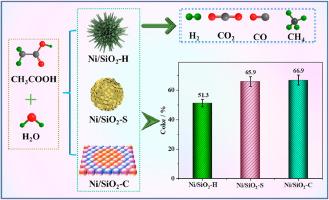Tailoring intermediates in steam reforming of acetic acid via porosity-confined acid sites on Ni/SiO2 for enhanced catalytic activity
IF 6.2
2区 工程技术
Q2 ENERGY & FUELS
引用次数: 0
Abstract
Although non-noble Ni-based catalysts exhibit high activity in the steam reforming for hydrogen production, their rapid deactivation caused by sintering of active sites and carbon deposition remains a major obstacle. This study investigated the effects of SiO2 support synthesis methods-hydrothermal (SiO2-H), Stöber (SiO2-S), and commercial (SiO2-C) on the catalytic performance and coke resistance of Ni/SiO2 catalysts in steam reforming of acetic acid. Catalytic activity tests revealed that hydrothermally synthesized Ni/SiO2-H achieved exceptional H2 yields of 91.3 % and near-complete acetic acid conversion (99.4 %) at 600 °C, outperforming Ni/SiO2-S (73.3 % H2 yield) and Ni/SiO2-C (71.2 % H2 yield). In-situ DRIFT measurement identified transient surface intermediates and indicated that Ni/SiO2-H exhibited rapid intermediate turnover frequency, attributable to its dendritic mesopores, abundant acid sites, and hydroxyl-rich surface. These characteristics promoted efficient gasification of reactive fragments, thereby minimizing carbon retention. Thermogravimetric analysis revealed superior coke resistance for Ni/SiO2-H (51.3 wt% coke vs. 65.9–66.9 wt% for Ni/SiO2-S and Ni/SiO2-C) and higher oxidation temperature of coke (621 °C), indicative of more graphitic carbon with enhanced stability in resulting carbon deposit. Transmission electron microscopy elucidated coke morphology disparities: smooth-walled carbon nanotubes formed via controlled growth mechanisms over Ni/SiO2-H, while Ni/SiO2-S and Ni/SiO2-C as the catalysts generated defective carbon nanotubes and amorphous carbon due to pore confinement and impurity-driven nucleation. The synthesis-dependent structural properties of SiO2-hierarchical mesoporous (Ni/SiO2-H), layered mesopores (Ni/SiO2-S), and blocky mesopores (Ni/SiO2-C)-were conclusively linked to catalytic activity and carbon resistance.

通过Ni/SiO2上的孔隙限制酸位裁剪醋酸蒸汽重整中间体以增强催化活性
尽管非贵金属镍基催化剂在蒸汽重整制氢中表现出较高的活性,但由于活性位点的烧结和碳沉积而导致的快速失活仍然是一个主要障碍。研究了水热法(SiO2- h)、Stöber法(SiO2- s)和工业法(SiO2- c)三种SiO2载体合成方法对Ni/SiO2催化剂在醋酸蒸汽重整过程中的催化性能和抗焦炭性能的影响。催化活性测试表明,水热合成的Ni/SiO2-H的H2产率达到91.3%,在600°C下的乙酸转化率接近99.4%,优于Ni/SiO2-S (H2产率73.3%)和Ni/SiO2-C (H2产率71.2%)。原位漂移测量鉴定了瞬态表面中间体,表明Ni/SiO2-H表现出快速的中间转换频率,这归因于其树突状介孔、丰富的酸位和富含羟基的表面。这些特性促进了活性碎片的有效气化,从而最大限度地减少了碳潴留。热重分析显示,Ni/SiO2-H的抗焦炭性能优于Ni/SiO2-S和Ni/SiO2-C的抗焦炭性能(51.3% wt%,而Ni/SiO2-S和Ni/SiO2-C的抗焦炭性能为65.9 wt%),焦炭的氧化温度更高(621°C),表明石墨碳含量更高,碳沉积稳定性增强。透射电镜分析了焦炭的形貌差异:在Ni/SiO2-H上通过控制生长机制形成光滑壁的碳纳米管,而Ni/SiO2-S和Ni/SiO2-C作为催化剂,由于孔隙限制和杂质驱动成核而产生缺陷碳纳米管和非晶态碳。合成相关的sio2 -层状介孔(Ni/SiO2-H)、层状介孔(Ni/SiO2-S)和块状介孔(Ni/SiO2-C)的结构性质与催化活性和抗碳性密切相关。
本文章由计算机程序翻译,如有差异,请以英文原文为准。
求助全文
约1分钟内获得全文
求助全文
来源期刊

Journal of The Energy Institute
工程技术-能源与燃料
CiteScore
10.60
自引率
5.30%
发文量
166
审稿时长
16 days
期刊介绍:
The Journal of the Energy Institute provides peer reviewed coverage of original high quality research on energy, engineering and technology.The coverage is broad and the main areas of interest include:
Combustion engineering and associated technologies; process heating; power generation; engines and propulsion; emissions and environmental pollution control; clean coal technologies; carbon abatement technologies
Emissions and environmental pollution control; safety and hazards;
Clean coal technologies; carbon abatement technologies, including carbon capture and storage, CCS;
Petroleum engineering and fuel quality, including storage and transport
Alternative energy sources; biomass utilisation and biomass conversion technologies; energy from waste, incineration and recycling
Energy conversion, energy recovery and energy efficiency; space heating, fuel cells, heat pumps and cooling systems
Energy storage
The journal''s coverage reflects changes in energy technology that result from the transition to more efficient energy production and end use together with reduced carbon emission.
 求助内容:
求助内容: 应助结果提醒方式:
应助结果提醒方式:


